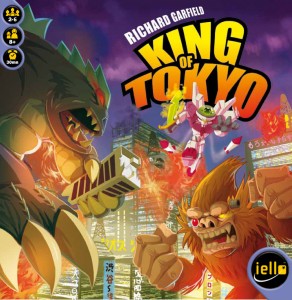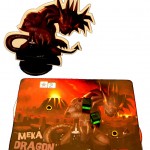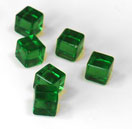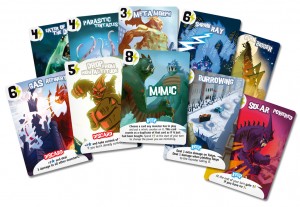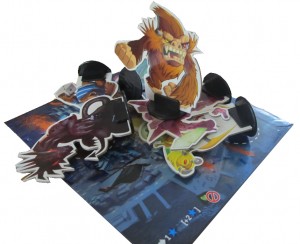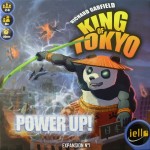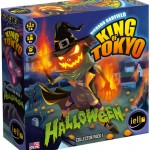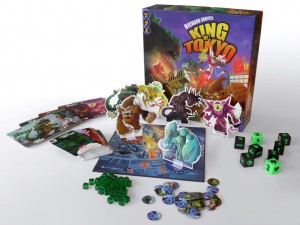King of Tokyo – A King-of-the-Hill Dice Game

We interrupt this program for an important news bulletin. Giant mutant monsters have invaded Tokyo and are laying waste to the city. While the monsters appear to be more concerned with fighting amongst themselves than attacking the population, residents should evacuate the area immediately…
Such is the theme of the dice-rolling game King of Tokyo, in which players play giant mutant monsters duking it out king-of-the-hill-style. The last monster standing – or the first to become fabulously famous – earns the lofty title King of Tokyo!
The giant mutant creatures featured in King of Tokyo were clearly inspired by classic monster movies. The King, for instance, bears a striking resemblance to King Kong. Likewise GigaZaur is reminiscent of Gozilla. The others are less obvious. The color scheme and weapons carried by Alienoid make me think of Marvin the Martian menacing the countryside in a tripod fighting machine right out of War of the Worlds. MekaDragon could be a mecha-version of King Ghidorah, but with only one head instead of three – there was Mechagodzilla after all. For some reason, Kraken reminds me strongly of Cthulhu – probably the color – but is more likely a play on Ebirah, the giant lobster kaiju who first appeared in the 1966 film Godzilla vs. the Sea Monster. And finally, if you expose the Energizer Bunny to a great deal of radiation, you could get CyberBunny!
Players begin King of Tokyo by choosing one of the aforementioned monsters to play, taking both the monster stand-up and its corresponding monster board with two gauges on it. One gauge – hearts – keeps track of your health – you start with ten. The other – stars – keeps track of your fame/victory points.
Game play is fun and simple. On your turn, roll the dice up to three times, setting aside any dice you want to keep as you go. The sides of the custom six-sided dice feature: heart, claw, lightning bolt and the numbers 1, 2 and 3. Hearts let you heal; claws deal damage; lightning bolts represent radioactive energy, which causes you to mutate and gain special abilities; and three dice of the same number score you points.
When you’re satisfied with your roll, or you’ve rolled three times, resolve the dice results:
- For each heart you rolled, heal one point of damage (up to the maximum of 10 – unless you have a mutation that says otherwise) as long as you’re not in Tokyo. Hearts can’t heal you while you’re in Tokyo.
- For each lightning bolt, take one energy cube.
- If you rolled at least three dice of the same number, score points. Three 1s scores 1 point; three 2s, 2 points and three 3s, 3 points. Each additional die of the same number scores one additional point. Thus, four 2s are worth 3 points.
- For each claw you rolled, deal damage to your fellow monsters: if you’re inside Tokyo, you damage all monsters outside of Tokyo; if you’re outside Tokyo, you damage all monsters inside Tokyo. When you hit a monster inside Tokyo, that monster can choose to yield Tokyo to you (after recording the damage) – assuming you didn’t kill him, that is. If the monster yields – or dies – you must enter Tokyo. So be wary of rolling claws if your health is poor.
Entering Tokyo is dangerous, so whenever you enter Tokyo you earn a point. Holding Tokyo is even more dangerous: the constant barrage from the all of the monsters outside of Tokyo can kill you fast. If, however, you’re able to survive the onslaught and are in Tokyo at the beginning of your next turn, you earn two more points.
Optionally, at the end of your turn, you can use your accumulated energy cubes to buy one or more Power Cards from the three currently available – each card’s cost, ranging from 2 to 8 energy, appears in its top left corner. There are two types of Power Cards: Discard and Keep. Discard cards have a one-time effect: resolve it immediately, then Discard the card. For example: Gas Refinery, which costs 6 energy, gives you 2 points and deals 3 damage to all other monsters; Heal, at a cost of 3, allows you to heal 2 damage – even if you’re in Tokyo. Keep cards provide an ongoing special ability. For instance, Telepath (cost of 4) allows you to spend 1 energy for 1 extra reroll. The more expensive Extra Head (cost of 7) gives you an extra die to roll. The 5-cost Spiked Tail lets you deal 1 extra damage whenever you attack. If you don’t like any of the cards available for purchase, you can always spend two energy cubes to clear the display and turn up three new ones.
After you’ve completed your turn, pass the dice to the next player. Play continues until only one monster is left standing or a monster becomes famous by earning 20 points. This monster is the King of Tokyo!
King of Tokyo is fun and interactive. It doesn’t feel like a high-conflict game despite its player elimination, King-of-the-Hill mechanic. Perhaps it’s because the conflict isn’t one on one. Instead of choosing one opponent to pick on, you deal damage to all monsters inside Tokyo when you’re outside Tokyo and to all monsters outside Tokyo when you’re inside. It doesn’t feel as personal then. The artwork and components enhance the lighthearted feel and appeal. It’s possible to simply rack up points by rolling triple numbers and acquiring the right cards and win the game without ever entering Tokyo. It’s possible. So there are multiple paths to victory.
Two expansions are available for King of Tokyo: Power Up! and Halloween. The Power Up! expansion adds a unique Evolution deck of eight cards for each monster, along with a new character – Pandakai. In the King of Tokyo base game, all monsters are essentially the same – only their artwork is different. With the Power Up! expansion, however, each monster can evolve into a unique creature. Whenever the final result of your dice rolls includes 3 hearts, your monster evolves. You can still use your hearts to heal as normal – unless you’re in Tokyo, of course. Even if you can’t heal – because you’re in Tokyo or are full up – you can still use 3 hearts to evolve. There are two types of Evolution cards: Temporary Evolutions and Permanent Evolutions. You can play a Temporary Evolution whenever you want for a one-time benefit, then discard it. When you play a Permanent Evolution, it remains in front of you and provides an ongoing benefit or special ability. Evolutions are unique to each monster. The rule sheet provides a few different options for using the Evolution decks, including an evolution draft which is bound to result in some crazy monsters.
King of Tokyo: Halloween includes two new monsters – Pumpkin Jack and Boogey Woogey – each with its own Evolution deck so it can mutate into an even more nightmarish version of itself! It also includes six orange-and-black engraved dice (to suit the Halloween theme), and twelve new Power cards you can add to the deck. The additional cards are Costumes – a new type of card that provides a powerful special effect. Players can steal Costumes from other monsters when they roll three claws. While the box denotes the Halloween expansion as “Collector Pack 1,” we haven’t seen or heard of a second Collector Pack as yet.
King of Tokyo supports 2 to 6 players ages 8 and up. Younger players that are just learning to read could certainly play with a little help. Play time is a quick 30 minutes. Replayability is good. There are 66 cards in the Power Card Deck, each a unique one-time benefit or ongoing special ability. Add to that the difference in players’ playing styles and what they make of their dice rolls (always a random thing), and every game is a fresh adventure to see who will be proclaimed the King of Tokyo.
You might also be interested in King of New York, the sequel to King of Tokyo.
Copyright © 2015-2024 by Tina G. McDuffie. All rights reserved.

